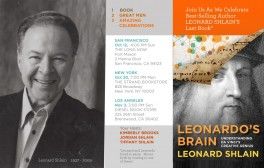Leonard Shlain was a successful inventor, surgeon and best selling author of books like: Art & Physics; The Alphabed Versus The Goddess; Sex, Time, and Power. He died in May 2009 at age 71. His last book, published posthumously by his loving daughters, is: Leonardo’s Brain. Understanding Da Vinci’s Creative Genius which was published by the Lyons Press in 2014. It is a wonderful book written following a research on Leonardo Da Vinci which, I am sure, had been going on for several years. There is a moving ‘Note to the Readers’ written by the author’s three daughters, opening with the discovery of a stage 4 brain tumour on September 6, 2008 in their father’s head, and being given 9 months to live. Up to that moment he had been busy putting the final touches to his book on Leonardo’s brain. Leonard Shlain decided to live his last months on earth in the best possible way and terminate his latest book. Then we read an ‘Author’s Note’ dated one month before Shlain’s death, in which he tells how he discovered his terrible disease, and then he adds: ‘ I have poured myself into this book by reading and synthesising an enormous amount of background information about Leonardo and the evolutionary development of the brain. In this book I aim to present original theories that weave together the different aspects of Leonardo’s life (and brain) and have not yet been considered by previous scholars from the fields of psychology, art history, and science. In doing so, I hope to stimulate new thinking about Leonardo and humankind alike.’
The problem which all scholars writing on Leonardo have to tackle is the scarcity of original notes coming down from Leonardo Da Vinci and the incredible number of accretions created around him by biographers, enthusiasts, novelists: some of those data are likely to be true, some are plainly wrong and false. It has been rightly noted that the image we form about Leonardo change with the changing of our society but a new and honest biographer has to be able to separate reality from unreality, wheat from the chaff. Not a easy task… The approach taken by Leonard Shlain is wide, drawing from art – first a very brilliant and very original comparison between Marcel Duchamp and Leonardo – and modern discoveries in the field of psychology and on the functioning of the human brain (this is the best part of his book). I have to point out some small imprecisions on the biographical side, which are indeed common among American biographers who cannot rely on marginalia published in Italy and then never translated into English. With people who know Leonardo Da Vinci deeply the impression that will get is that some of his intuitions and inventions are a bit over-inflated, this is certainly due to the great passion Shlain has for him. For instance Leonardo’s abilities as a war engineer – he never invented anything new in this field and he missed to spot the real innovations which were appearing right under his own eyes, like the new generation of cannons used by the French army invading Italy – which were not existing but, as we have already pointed out, Shlain had to rely on Leonardo’s biographers whose books are best sellers in several countries and include some spectacular but undocumented hypothesis presented not as what they are but as facts. In spite of the understandable shortcomings he final result reached by Shlain is highly credible and the book turn out to be very readable and full of wisdom and beauty.
I found particularly original and illuminating some of the points made by Shlain. I ‘ll quote only two: the importance of the landscape in Leonardo’s portraits, points clearly visible for the Mona Lisa and the Ginevra de’ Benci. The idea that a man or a woman could be part of a landscape was totally new in the West – it was not so in Roman and Greek times – and contrary to people used to monotheistic religions: like Hebrew, Christian and Islam. The man was seen as an image of a powerful God, separated from nature. However it was a common concept in countries were Buddhist was the State religion, and this could explain why landscape painting was such a common feature among Chinese artists. The second concern Leonardo’s ‘Last Supper’ as moving on different plains: past, present and future, which is indeed a very original and fresh intuition. That could explain the amazement of Rafael on seeing it: he stood there, stunned with his mouth open, in front of it, so Vasari tells us.
This is a great book and a great pleasure to read, a triumph over death, and is a book which will leave a deep mark in the long list of first class biographical studies dedicated to Leonardo Da Vinci.
Leonard Shlain Leonardo’s Brain. Understanding Da Vinci’s Creative Genius Lyons Press, 2014. ISBN978-1-4930-0335-8.

